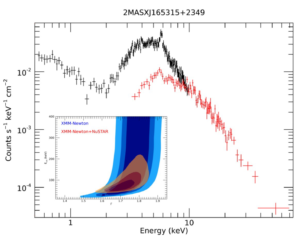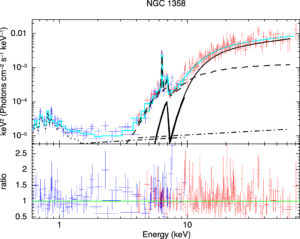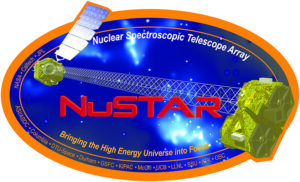The NUclear Spectroscopic Telescope ARray (NuSTAR) mission is a NASA Explorer launched in 2012. The first hard X-ray focusing satellite ever developed, NuSTAR is hundreds of times more sensitive than previous hard X-ray missions. By operating in the energy range 3-79 keV, it is the ideal companion in the exploration of the energetic Universe for soft X-ray observatories such as XMM-Newton, Chandra and Swift. NuSTAR has also worked successfully in synergy with non-soft X-ray facilities such as INTEGRAL, Fermi, the Hubble Space Telescope, and Spitzer.
NuSTAR main scientific goals
- Probe the supermassive black hole population at all scales and up to cosmic Noon (z~2-3);
- Characterize Galactic compact objects.
- Study relativistic jets in the most active galaxies as powerful cosmic accelerators.
- Map the radioactive material in Supernova remnants to understand explosion and nucleosynthesis mechanisms.
INAF-OAS Bologna and NuSTAR
The Italian Space Agency (ASI) is directly involved in the NuSTAR mission, providing the ground station in Malindi (Kenya), as well as the data reduction software support and archival storage at the ASI Science Data Center (ASDC).
- INAF-OAS Bologna scientists part of the NuSTAR team: Andrea Comastri, Giorgio Lanzuisi, Stefano Marchesi.
- Other people at INAF-OAS involved in the analysis of NuSTAR data: Massimo Cappi, Mauro Dadina, Roberto Gilli, Angela Malizia, Manuela Molina.
- Collaborators at UniBo involved in the NuSTAR data analysis: Elena Bertola (Università di Bologna), Marcella Brusa (Università di Bologna), Gabriele Matzeu (Università di Bologna), Francesco Salvestrini (Università di Bologna), Alberto Traina (Università di Bologna), Cristian Vignali (Università di Bologna).
INAF-OAS Bologna-led NuSTAR projects

XMM-Newton and simulated NuSTAR spectrum of 2MASXJ165315+2349, a z=0.103 quasar where supermassive black hole winds have been detected.
New constraints on the high-energy cutoff in AGN spectra
We have been involved in the first measurement of the high energy cutoff and reflection properties in high redshift quasars combining NuSTAR and XMM-Newton data. We also obtained complete NuSTAR follow-up (Cycle 6, 630ks, PI S. Bianchi) of the SUBWAYS sample with the aim of constraining the continuum photon index and high energy cutoff in a sample of 20 local Seyferts and Quasars with SMBH winds properties fully characterized thanks to deep XMM-Newton coverage (AO18, 1.6Ms, PI Brusa).
Relevant publications
- G. Lanzuisi, M. Perna, A. Comastri, M. Cappi, R. Gilli, M. Dadina, M. Brusa, C. Vignali, and collaborators; NuSTAR reveals the extreme properties of the super-Eddington accreting supermassive black hole in PG 1247+267, A&A, 2016, 590, 77
- G. Lanzuisi, R. Gilli, M. Cappi, M. Dadina, M. Bianchi, M. Brusa, G. Chartas, F. Civano, A. Comastri, A. Marinucci, R. Middei, E. Piconcelli, C. Vignali, W.N. Brandt, F. Tombesi, M. Gaspari; NuSTAR Measurement of Coronal Temperature in Two Luminous, High-redshift Quasars, ApJL, 2019, 875, 20
- M. Molina, A. Malizia, L. Bassani, F. Ursini, A. Bazzano, P. Ubertini; Swift/XRT-NuSTAR spectra of type 1 AGN: confirming INTEGRAL results on the high-energy cut-off, MNRAS, 2019, 484, 2735

Joint NuSTAR (shown in red) and XMM-Newton (shown in cyan) spectrum of NGC 1358, a z=0.103 Compton-thick AGN from the Clemson Compton-thick sample. The best-fit model is also shown (solid black line). From Zhao et al. (2019a).
A complete census of heavily obscured AGN in the Local Universe
Exploiting NuSTAR unprecedented effective area at energies above 10 keV, we are working on a detailed characterization of the heavily obscured active galactic nuclei (AGN) in the local Universe (i.e., within redshift z <0.05, or d <200 Mpc) observed between 15 and 150 keV. Heavily obscured AGN are expected to be a significant fraction of the overall AGN population, but the vast part of them remain hidden, invisible to optical facilities. Hard X-ray emission can shine through large column gas densities, which completely obscure longer wavelengths: this makes NuSTAR the ideal instrument to understand the physical and geometrical properties of the material surrounding accreting supermassive black holes.
The results of this project and the data products are available on Clemson-INAF Compton-thick AGN webpage.
Relevant publications
- S. Marchesi, M. Ajello, L. Marcotulli, A. Comastri, G. Lanzuisi, C. Vignali; Compton thick AGN in the NuSTAR era, 2018, ApJ, 854, 49
- X. Zhao, S. Marchesi, M. Ajello, L. Marcotulli. G. Cusumano, V. La Parola, C. Vignali; Compton-thick AGN in the NuSTAR Era. II. A Deep NuSTAR and XMM-Newton View of the Candidate Compton-thick AGN in NGC 1358, 2019, ApJ, 870, 60
- S. Marchesi, M. Ajello, X. Zhao, L. Marcotulli, M. Balokovic, M. Brightman, A. Comastri, G. Cusumano, G. Lanzuisi, V. La Parola, A. Segreto, C. Vignali; Compton-thick AGN in the NuSTAR Era. III. A Systematic Study of the Torus Covering Factor, 2019, ApJ, 872, 8
- X. Zhao, S. Marchesi, M. Ajello; Compton-thick AGN in the NuSTAR Era. IV. A Deep NuSTAR and XMM-Newton View of the Candidate Compton-thick AGN in ESO 116-G018, 2019, ApJ, 871, 182
- S. Marchesi, M. Ajello, X. Zhao, A. Comastri, V. La Parola, A. Segreto; Compton-thick AGNs in the NuSTAR Era. V. Joint NuSTAR and XMM-Newton Spectral Analysis of Three “Soft-gamma” Candidate CT-AGNs in the Swift/BAT 100-month Catalog, 2019, ApJ, 882, 162
- X. Zhao, S. Marchesi, M. Ajello, M. Balokovic, T. Fisher; A Broadband X-Ray Study of a Sample of AGNs with [O III] Measured Inclinations, 2020, ApJ, 894, 71

